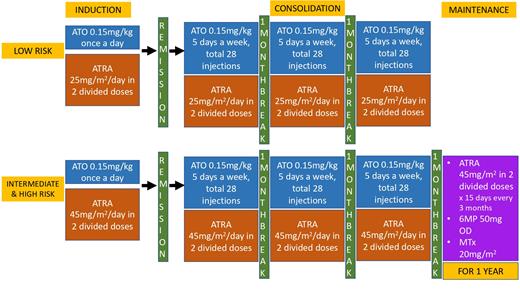INTRODUCTION
Advances in the treatment of Acute Promyelocytic Leukemia (APL) have enabled a large majority of the patients to be cured of this disease. However, with high cure rates now being achieved using Arsenic Trioxide (ATO) and All Trans Retinoic Acid (ATRA) in the frontline setting, there is greater interest in looking at potential long-term side effects. In particular, the information regarding the potential impact on fertility has not been well studied. ATO has been shown to be associated with adverse pregnancy outcomes in animal models, while studies in humans have mixed results. We looked to study the impact on fertility of patients with APL treated at our center over the past 17 years.
METHODS
We retrospectively analysed all patients with classical APL treated at our center with ATO and ATRA from 2006-2022. Patients between the age of 18 and 40 years, who had completed therapy, were in molecular remission and on regular follow-up were included in the study. All patients were treated with ATO and ATRA during induction therapy, followed by 3 cycles of consolidation with ATRA and ATO, each 1 month apart. Patients with intermediate and high-risk APL also received maintenance therapy for 1 year with ATRA, 6 Mercaptopurine and Methotrexate. The details of the treatment protocol are shown in Figure 1.
Patients were interviewed telephonically and details regarding any pregnancies post-therapy completion as well as any adverse pregnancy outcomes, including preterm birth, miscarriage and spontaneous abortion were noted. Information was also gathered regarding presence of any physical anomalies in children born after therapy completion.
RESULTS
Sixty patients were included in the study with an equal number of male and female patients in the study (30 each). The median age of the patients at diagnosis was 23 years (Range 18 - 33 years). Three patients were unmarried and hence were excluded from the study.
Forty-six patients (80.7%) did not try to conceive a child post therapy. Most patients cited their family being complete as the reason for not trying to conceive another child (N=40; 86.9%). Four patients did not try to conceive a child post therapy due to fear of disease returning, while 1 patient each did not try to conceive a child due to fear of risk to the unborn child and because they had not yet planned for a family.
Eleven patients (19.3%) had 12 children post therapy, including 7 male and 4 female patients. The median time from therapy completion to first successful conception was 1.5 years (Range 0.5 - 3 years). Seven of these eleven patients did not have children prior to the diagnosis and therapy for APL. The median cumulative ATO dose during therapy was 996mg (Range 648mg - 1188mg). All patients who tried to conceive a child were able to successfully conceive and have a successful pregnancy post treatment for APL. None of the patients used any fertility therapy for conception of pregnancy. There was no history of pre-term birth, miscarriages or spontaneous abortions in any patient. None of the children had any obvious congenital abnormalities as reported by the patients.
CONCLUSION
All patients (male and female) who wanted to conceive children were able to successfully conceive and bear children post therapy for APL in our study. ATO and ATRA can safely be used for the treatment of patients with APL and appears to have little, if any, impact on long term fertility.
Disclosures
No relevant conflicts of interest to declare.


This feature is available to Subscribers Only
Sign In or Create an Account Close Modal